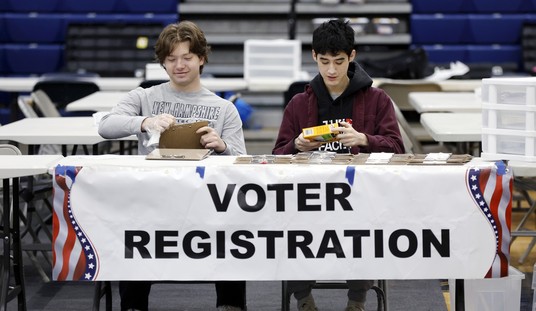
I’ve lately knocked liberals and conservatives alike lately for unrealistic ideas about winning elections by base turnout alone – liberals for clinging to the Static Electorate Fallacy that assumes it will be 2012 forever despite powerful historical evidence that each new set of candidates create their own turnout once an incumbent departs the ballot, conservatives for overstating the number of conservative voters who may have sat out the 2012 and/or 2008 elections in protest over moderate nominees. But a closer look at the two parties’ shares of the total pool of eligible voters reveals where Republicans need to do better in 2016, and where Democrats might be in danger of doing worse.
The Missing Million
In my last piece, I demonstrated why Republican vote totals from 2004, 2008 and 2012 – as well as exit polls on the proportion of voters who self-identified as “conservatives” – illustrate that there’s no magic-bullet solution, no 3 or 4 or 5 million (or more) conservatives who have voted Republican in the past but sat out because Romney and/or McCain were too moderate. In raw numbers, the falloff from George W. Bush in 2004 to Romney in 2012 was only about 1.1 million voters, compared to Obama’s 5 million vote margin of victory in 2012, or Obama’s 10 million vote margin in 2008. Since at least some of those 1.1 million former Bush voters presumably switched sides to Obama (we all know some 1990s liberals who were national-security-first voters after 9/11 but later reverted to form), the actual number of missing Bush voters who thought McCain and Romney were not conservative enough and stayed home could be less than that.
One objection raised against my argument is that it dealt only in raw numbers, and ignored population growth. On the one hand, that was deliberate – my point is that the problem with Romney and McCain was much more an inability to persuade and inspire new voters and swing voters than some sort of en masse sitdown strike on the Right. On the other hand, it’s true that both candidates got some new Republican voters, so maybe that masks the overall size of the stayed-home contingent. Or maybe they didn’t – every cycle there are voters who die, get too old to vote (my dad drove with a McCain-Palin sticker on his car in 2008, but by 2012 was in a home and no longer capable of voting), or otherwise exit the electorate for good. It may well be there were more of those in the last two elections than new voters – given that Republicans lately have tended to do much better with older than younger voters, it’s quite likely. Either way, there’s no evidence that enough previous Republican presidential voters sat out in 2012 and/or 2008 to make a difference in the outcome. We’re looking for an effect so large that its absence of visible signs reminds me of Bill James’ description of the search for evidence that Ozzie Smith had saved the Cardinals 100 runs with his glove in 1982*:
The deal, you see, is this. For 100 years, baseball has been buried in a blizzard of records. On every season it has fallen, on every player, on every game and on every issue. And yet, people are fond of talking about these large factors in the game that don’t happen to show up in the records anywhere…Can’t you see how absurd it is? It’s like saying that there were a bunch of elephants playing in the snow, but they left without leaving any tracks. If there was an elephant in the snow, he’s going to leave some tracks. If there’s 100 runs out there, I can damn well find their tracks. Baseball has had thousands of shortstops, hundreds of thousands of seasons – and a blizzard that fell over each of them. There are too many counts of too many things for there to be any dinosaurs living out there without a trace.
* – For what it’s worth, James estimated that Ozzie saved the Cards 20-25 runs that year, and using a more generous measure, placed the upper end of his possible contribution at 31-37 runs. More modern defensive metrics developed since then estimate that Ozzie saved the Cards 21 runs that year compared to an average shortstop, an exceptional figure and the second-best of his distinguished career but still far short of 100. The lesson: sometimes better data tells you the elephant was never there.

Turnout Goes Up, Turnout Goes Down
But if the evidence doesn’t support the idea of a large-scale conservative walkout, it does show that Republicans lost in 2008 and 2012 not only because Democrats grew their vote as a share of all eligible voters, but also because Republicans got a smaller share of all eligible voters to show up and pull the lever for them. That’s partly a failure of persuasion and partly a failure of turnout (really the two are intimately related, since people who are not persuaded are a lot less likely to turn out). Either way, it suggests that the Romney and McCain campaigns failed for reasons beyond just facing the wrong opponent at the wrong time. Let’s walk through the evidence and see exactly how that shows up in the numbers.
Hard voter-turnout data can be surprisingly hard to come by, but the best (if imperfect) data in this area comes from political science professor Michael McDonald, now at the University of Florida, and his United States Elections Project. McDonald is somewhat left-leaning in his elections and poll commentary on Twitter and at the Huffington Post, but I’ve found his data to be useful and have never seen evidence of any bias in the numbers, just occasional limits in the availability of information despite McDonald’s best efforts. The rest of this column is based on analysis of the final vote figures from the last 4 national elections when combined with Prof. McDonald’s data, and I’m indebted to him for collecting it.
McDonald uses two measurements – Voting-Age Population (or VAP), which seeks to estimate the total number of people in a state old enough to vote at the time of an election, and Voting-Eligible Population (or VEP), which is the subset of VAP that are actually eligible to vote (e.g., not inmates, felons or non-citizens). Neither measure is limited to registered voters, nor should it be (successful campaigns register new people all the time). Unfortunately, on some occasions his charts are unable to provide an estimate of VEP, and in those cases I used VAP, so – especially when a state’s data switches back and forth between the two – the data is less useful in telling us what we need to know. Some states historically have much higher turnout than others (e.g., Upper Midwest states like Wisconsin and Minnesota or New England states like New Hampshire and Vermont), but all the comparisons I’m doing here are changes in the turnout within a particular state over time.
The next two charts – I break these in two parts for convenience and readability – show voter turnout for each state (and the District of Columbia) in each of the last four elections as a percentage of VEP, except in the shaded areas where it uses a percentage of VAP because that’s all that was available. Thus, for example, some of the apparent dropoff in turnout from 2004 to 2012 in Alabama, West Virginia, Delaware and Missouri, and the dropoff from 2008 to 2012 in Pennsylvania and Oklahoma, is partly a function of switching to a larger denominator. I’m using 2004 vs 2012 for three reasons: they’re both incumbent elections, so serve an apples-to-apples comparison; 2004 is the high water-mark of GOP turnout and vote share since the end of the Cold War, so serves as a useful test of the best recent conditions for a Republican; and Obama’s coalition was much more reliant on his demographic and cultural base voters in 2012, rather than people who just herded to him due to the 2008 financial crisis and Bush fatigue. It’s the 2012 electorate that Democrats look to as evidence that they have a permanent majority even without the perfect-storm conditions of 2008.

I’ve sorted this and the next chart by dividing the percentage turnout for 2012 by the percentage turnout for 2004 – thus, the states at the top are the ones where the parties in combination (albeit including third parties) did the best job of getting people excited to go vote for Obama and Romney, compared to how they did turning out people to go vote for Bush and Kerry. The states at the bottom of the second chart are the ones where turnout fell off the furthest from 2004 to 2012. I color-coded the states by a metric that is sadly important in the racially polarized electorate of the Obama years: racial demographics. The states in dark green are states where at least 20% of the population as of 2010 was African-American, the states in light green those where at least 10% was African-American. The states in tan, by contrast, are states where at least 80% of the population as of 2012 was non-Hispanic white. These are rough proxies for the voting-eligible population as of each year, but for these purposes rough measures will do to make the point.
There are eight states plus D.C. that are at least 20% black. As you can see, all eight of them had higher voter turnout in 2012 than in 2004, and they are heavily clustered near the top along with Virginia, which narrowly missed 20% (Alabama and Delaware would also likely rank higher if we had VEP numbers for 2012). This is consistent with studies showing that black voters – who long lagged in their turnout rates on Election Day – actually exceeded white voters in turnout rates in 2012, as well as with Sean Trende’s finding that white voters had unusually low turnout in 2012. Colorado and Nevada, two states where Democrats turned out large numbers of Hispanic voters in 2012, are also high up; the big Near-Midwestern states like Ohio and Pennsylvania are closer to the middle of the pack. Then we get to the low-turnout states:

Here we get a lot more states with big white (especially rural white) and/or Native American populations (I’ve remarked before on the signs that Native American turnout was way down in 2012 for reasons nobody’s tried to explain). You don’t need to be an especially shrewd observer of American politics the last eight years to notice that Barack Obama is especially unpopular in what was until recent years the solid Democratic stronghold of West Virginia, which is heavily white, rural and out of step with his secular, urban progressivism even if you don’t consider race as a factor (although again, absence of VEP data may exaggerate a bit of the 2012 falloff in WV). Texas turnout has been low and getting lower since 2008, in part due to higher prior turnout resulting from the popularity of George W. Bush in Texas, and perhaps due to a large segment of Texans over 18 being ineligible to vote.
But these are overall turnout numbers. Let’s look at turnout where it really matters – by party.
Who Turned Out And Who Did They Vote For?
The second step of my analysis is to multiply the percentage of the overall vote that each party got by the overall voter turnout percentage, to illustrate what percent of the eligible voters each party actually drew in each state in each election. For these charts, I used a similar ranking, with the states at the top being those where the Democrats got the biggest share of voters in 2012 compared to what they got in 2004, and the bottom being those where their voter turnout decayed the worst.

Interestingly, the state where the Democrats did the best at improving their turnout in 2012 (or rather, holding onto their improvement from 2008) was one Obama still lost – North Carolina. But improving from 22.7% of all eligible voters for Gore in 2000 to 32.6% in 2008 for Obama was a huge achievement. Once again, the heavily black states and heavily Hispanic Colorado and Nevada rank highly here, along with Obama’s home state of Hawaii. All of these will be hard to replicate behind an older white lady from the suburbs of Chicago. I boldfaced the states where one party got at least a third of the eligible vote – you’ll notice that outside of monolithically Democratic D.C., it’s extremely rare for any candidate to get close to an actual majority of eligible voters in even the reddest or bluest states, even in a national election. The winners in both 2000 and 2012 got less than 30% of the vote from all eligible voters nationwide (Bush got 26.5% in 2000, for example). A lot of people just never vote.
Then there’s the states at the bottom of the scale:

Louisiana is the one heavily African-American state that slides down to the second level when you break things out by party, and you see the catastrophe for Democrats under Obama in West Virginia, Arkansas and Tennessee playing out here (Tennessee has been getting steadily redder relative to the country since at least the 80s and really since several decades before that).
Now, we’ve set the stage to examine Republican turnout.
Where Did Romney and McCain Fall Short?
The next two charts rank the states by how the average GOP turnout over the 2012 and 2008 elections compares to the Bush 2004 vote. For comparison, I also have columns comparing Romney to McCain, and Bush ’04 to Bush ’00.

Overall, we do see that when adjusted for the growth of the voter-eligible population, McCain managed only 91.2% of Bush’s vote, and Romney even less – 89.7%. So, while “millions of conservatives stayed home” may be a myth, the reality is that both of the last two GOP contenders fell pretty far short of Bush’s 2004 numbers as a proportion of the electorate – had they turned out as many voters as Bush, proportionally, McCain would have received an extra 5.8 million votes, Romney almost 7 million. Then again, Bush himself – as an incumbent – got a lot more people out to vote than he had in 2000. Romney/McCain turnout exceeded Bush 2000 turnout by 5.3%. The lesson, as usual? The electorate is fluid, not static. Better candidates can turn out more voters (as we’ll see again below regarding Democratic turnout), but historically the best candidates of all are still incumbents, and neither side has one of those this year.
We can also see that Romney’s positive progress over McCain was wholly an illusion created by population growth and Obama’s own decline – he really did lose ground as a proportion of eligible voters. Romney improved on McCain’s showing in some states (like Mormon-heavy Utah and Nevada, [mc_name name=’Rep. Paul Ryan (R-WI)’ chamber=’house’ mcid=’R000570′ ]’s home state of Wisconsin, and ethanol states like Iowa and Indiana that hated McCain) but overall he got 98.4% of McCain’s turnout share.
Looking at individual states, there are some special cases. Hawaii was a wipeout for McCain that got worse under Romney, but that’s partly explained by Obama’s home-state advantage plus the state’s traditional strong preference for incumbents (Bush improved by 31.4% there in 2004 over 2000). Texas, of course, was never going to be quite as favorable without a Texan president. The GOP has been decimated (and then some) in a number of the bluest states, including NY-area states where Bush in 2004 still had some lingering post-9/11 support, while Romney had Hurricane Sandy flooding out Staten Island and the New Jersey and Connecticut suburbs.
But aside from New Mexico (which was basically a state Bush lucked into in 2004) and Indiana (which Obama lucked into in 2008), the real swing states are mostly not much worse cases than the overall national average, meaning that McCain and Romney weren’t ill-suited to Ohio, Nevada and Iowa so much as just poor candidates for the whole country whose weaknesses flowed down to the states.

Only in six states did Romney beat Bush’s turnout; McCain did it in eight. One of those was Massachusetts, where Romney had been governor, while Bush was running against a Massachusetts Senator. One, only for Romney, was North Carolina – the one contested state Romney stole back from Obama, and for which the GOP can take legitimate credit (Romney’s 33% of eligible voters is genuinely impressive), and where it also won a very narrow Senate race in 2014 (if I were running a GOP ground game this year, I’d take a look at how turnout has been working in the Tarheel State). There’s also Arkansas, which has been consistently trending red. Overall, besides Romney’s and McCain’s home states, the bottom of the chart is mostly Southern states where the GOP has a strong, deep local organization and Obama is intensely unpopular with white voters.
At the other end of the scale, we have four more big potential swing states where the GOP still has problems keeping up with the growth of the electorate – Colorado, Florida, Pennsylvania, and Virginia. They may be in better shape than the nation in terms of GOP turnout, but they were still way off 2004.
Where Will Hillary Have Her Work Cut Out For Her?
Let’s come back now to the Democrats’ issues. Obama’s loss of 3.5 million voters in 2012, when incumbents are usually expanding their coalition, gets even worse in percentage terms – at 2008 Democrat turnout rates, he’d have gotten an additional 5.9 million votes, and 2012 national turnout was only 2% better than Kerry’s:

By contrast, his overall turnout rates combining both elections were up 11.4% vs Kerry/Gore, and 2008 was up 21.7% from Al Gore’s 2000 showing. Once again, ranking the states by the left-hand column (Democratic 2012 vs Democratic 2004 turnout), we see a disproportionate concentration of states with big black populations at the top, and except for Ohio, most of the states that Obama won that Kerry and/or Gore had lost. Democrats will need a strategy for replacing some of that black turnout if it turns out not to be replicable without Obama.

At the other end, we have 23 states where Obama performed more poorly than Kerry. The bulk of these are red Southern or Western states, but there’s also Ohio, Pennsylvania, and Minnesota. The optimist’s case for Democrats is that Hillary might restore them to Kerry levels of turnout; the pessimist would say those trendlines show where there’s a lot of work to be done.
(As a brief digression, I haven’t delved into which states changed their election laws since 2004 – obviously, some states might attribute rising turnout to innovations like same-day registration or early voting).
Just to drive home further the demographic issue, here’s the turnout figures for the last two (Republican-dominated) midterm elections, sorted from the states with the largest turnout falloffs from 2008/2012 levels to 2010/2014 levels, down to those with the smallest (all states see less turnout in midterms, almost without exception):

Once again, wee see the states with bigger black populations clustered nearer the top, although there are a variety of extenuating issues – D.C. sends no voting representatives to Congress, and Virginia, New Jersey, Missisippi, Indiana, North Carolina and Louisiana don’t elect Governors in even-numbered midterms. Whereas here are the states that have had smaller dropoffs in the midterms – the pattern should be coming into view:

In fact, if you look at the column comparing 10/14 midterm turnout to the 2000 and 2004 electorates, the correlation with high black population states having larger midterm dropoffs, and high white populations having smaller ones, doesn’t disappear but it does become less dramatic. In other words: 2008 and 2012 really were different for black voters, regardless of how much of that difference was due to the first black president being on the ballot. Hillary Clinton’s challenge will be to do what her party’s heavily white 2010 and 2014 candidates couldn’t even with Obama in office and out on the campaign trail – reach and turn out the marginal black voters who have thus far turned out for Obama, and for nobody else.
Miles To Go Before We Sleep
As for Republicans, well, we’re still busy picking a nominee, and that means more arguments about who might be able to improve the GOP’s share of the potential electorate from Romney’s 27.6% and McCain’s 28.1% to somewhere at or above 30%. While there may not be any missing conservative cavalry on the way, 2016’s candidate will need to put some real effort not only into persuading wavering Obama 2012 voters but also into getting new people registered, inspired and activated. It won’t be easy – Google billionaire Eric Schmidt is working on a massive Big Data project for the Democrats, which is likely to be more sophisticated and integrated with the party apparatus than the Koch brothers’ network’s $750 million grassroots investment on the Right, and the fragmented GOP field may still be overinvesting in television ads instead of turnout, while Republican digital efforts are lagging. Those operational disparities – a major reason, even aside from policy results, why Democrats trust their party establishment more than Republicans do – didn’t save the Democrats in 2010 and 2014, and they won’t save Hillary if Republicans have a much more attractive candidate. But in a close race, turnout can matter a lot. 2016 will reveal whether the Republican Party has learned anything from the Romney and McCain defeats.













Join the conversation as a VIP Member